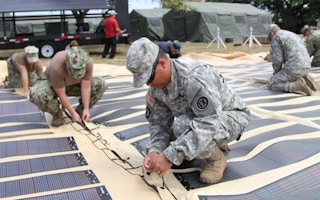Over the last two years, President Trump has made every effort to rescue America’s ailing coal industry, opening public lands to mining, weakening limits on pollution, and potentially eliminating protections for miners. It hasn’t worked. Utilities continue to shutter coal-fired power plants, and mining firms continue to shed workers.
Desperate to throw a lifeline to the coal sector, the administration has considered directly subsidising coal in the name of national security. Coal-fired power plants, they say, are essential to grid security, as they are uniquely able to withstand a cyber attack or a natural disaster and continue to generate power on demand. But as experts have pointed out, nothing could be further from the truth. As it happens, locally sourced renewable power, not coal, promises the most resilience in the face of a catastrophe.
That’s why the military has embraced clean energy—for the sake of national security.
A new report from the Association of Defense Communities and Converge Strategies details how military bases are turning to renewables to guard against blackouts in the wake of floods, storms or cyber attack. “The [Department of Defense] is deploying these projects because of increasing threats to the US electric grid,” said Wilson Rickerson, a principal at Converge Strategies and a co-author of the report.
“
The Department of Defense has made energy resilience a priority, and communities and states who can help achieve this goal will be in a stronger position to retain missions and attract new ones.
Tim Ford, chief executive officer, Association for Defense Communities
The report details how adversaries such as China, Russia, Iran and North Korea are developing the ability to launch cyberattacks on critical infrastructure—Russian hackers have already proven capable for breaking into the power grid. In response, bases are developing microgrids, installing wind turbines, solar panels, batteries and diesel generators that can supply power in the event the grid fails.
Rickerson noted that, in many cases, bases are partnering with local developers and electric utilities on renewable energy projects that serve not just the base, but the surrounding community as well. The report describes several instances where microgrids are making bases more resilient while supplying clean power to nearby homes and businesses.
- The Naval Construction Battalion Center in Gulfport, Mississippi hosts a 29,000-panel solar array that feeds into the power grid. The array is owned by a private company that, in exchange for use of the land, is installing diesel generators and battery storage on site. In the event of a blackout, the generators, battery and solar panels will power the base.
- Marine Corps Air Station Miramar in San Diego, California features a solar array, battery storage, and gas and diesel generators, as well as two generators that burn gas seeping from a landfill onsite. The microgrid is helping the Marine Corps save money on electricity, and in the event of an emergency, it can power the entire base for three weeks.
- The Otis Air National Guard base on Cape Cod, Massachusetts boasts the military’s first wind-powered microgrid. The installation, which includes one wind turbine, a diesel generator and battery storage, can power the base for up to 120 hours in the event of an outage. The project was funded in part by the state of Massachusetts, which is working to develop renewable energy on military bases.
The report encourages more states and cities to partner with military bases on projects like these. “The partnership models highlighted in this report are powering military missions and can be scaled to benefit surrounding communities and economies,” Rickerson said. Onsite clean-energy projects, the report notes, can create jobs and help limit pollution.
“The Department of Defense has made energy resilience a priority, and communities and states who can help achieve this goal will be in a stronger position to retain missions and attract new ones,” said Tim Ford, CEO of the Association for Defense Communities. “It can also improve the resiliency of communities, which is important when you have 70 per cent of military families living off-base.”
In many ways, the US military stands at the vanguard of the transition to clean energy. Troops in the field have deployed solar power and batteries to reduce their reliance on oil and gas, saving money and helping to guard against attack. Fuel convoys are frequent targets for roadside bombs, and diesel generators can be a liability when under siege. Firsthand experience with clean energy leads many veterans to pursue careers in the industry after they leave the service.
Kevin Johnson, an Army veteran who now runs GlidePath Federal Solutions, a developer of resilient energy systems for the Department of Defense, said that when men and women work on a base powered by solar, “they’re going to see, right there on the base, that solar is viable, that the military finds value from energy security and energy resiliency.” The fact that so many veterans are then drawn to jobs in clean energy is a testament to this fact.
Far from making the grid more vulnerable to disasters and attacks, wind, solar and battery storage are making the grid more resilient. The military is helping to prove that.
This story was published with permission from NexusMedia.










